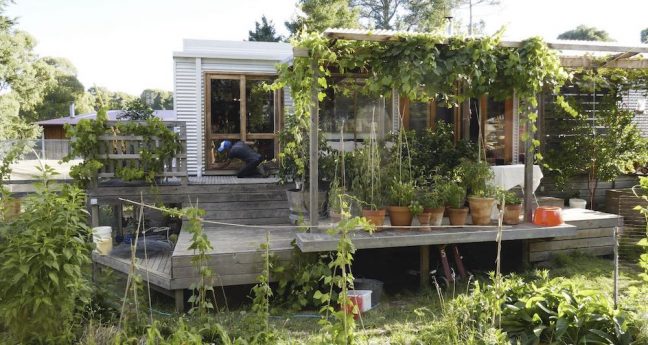Contributor: Katie Kristensen
Photo sources: Serena King, Sam Ralph, WMNC, and Katie K
The Heemskirk Community Garden was on our permie group’s radar because for many of our members it is their closest community garden. Sadly, it was targeted by thieves last month and 6 trees were stolen from the August orchard planting. So a few of our group were really keen to lavish a little love on the garden to balance the scales.
Serena and I joined forces again to co-facilitate the day and found that working on a community space is a very different kind of ‘blitz.
Heemskirk Garden is a newly developing garden; located in Warrane and a project coordinated by the Warrane Mornington Neighbourhood Centre (WMNC), it has been transformed from an empty block to the pictures you will see below.
Make no mistake, this progress has involved a lot of discussions by WMNC with community members, relationship building and networking, grant applications for infrastructure to begin and then more applications to fund the elements that make a garden look like a garden; the lovely beds, awesome fruit trees and other plantings. The Heemskirk Community Garden started visibly coming together at the beginning of 2019. Initial research and planning started as far back as 2015.
Leah (WMNC’s Project Officer) was so lovely to work with. She balanced our enthusiasm for working on permie elements from the original plan with reminders that they are still in the process of creating a new working committee to guide the progress of the garden into the future.
Serena and I focused on the priority of helping to make the garden look loved and welcoming in its current form for the WMNC’s Community BBQ day (to bring folks into the garden and encourage more community engagement). And into that brief we were able to work a food forest section on one of their growing mounds.
Our blitz day in photos….
There were lots of weeds to tackle in the orchard rows and pockets! We wanted to get to all of them because each tree has been sponsored by individuals, groups, businesses and government reps with links to the community.




Donated mosaic art pieces were installed at the sites of the stolen trees
until replacements are planted next year.


We also sheet mulched part of a growing mound to start improving the soil for future plantings. One of our worker bees on the day had brought along some pigface so we also planted it here to start a living mulch cover until further decisions are made for this mound.






And the food forest… Serena and I are so grateful to Paul from Tiger Hill Permaculture who made the trip from Buckland to give us a hand with the day (with two of his current Help X’er’s in tow). Luise and Yayoi had collected a huge number of seedlings for us from Paul’s garden to plant out in the food forest and Paul brought his experience, which proved invaluable!
In hindsight it seems like such an obvious call but it wasn’t until we were discussing how we would plant out the growing mound that Paul suggested we start by creating swales on contour in the mound to help capture and slow down water and sink it in, rather than letting it run off the mound shape (as it would have). With his extensive earthworks experience, Paul dug out those swales on contour by eye, in what seemed like no time at all. They will have the water retention benefits but also the berms (upsides) created by the swales (dips) lend themselves to tripling the planting space – in their sides, along their top and of course in the swale itself. So good!


as Paul also made pretty short work of creating them.




Massive thanks to everyone who came along and contributed time, labour, ideas, seeds, seedlings, food, tools, cheer and some great discussion. Extra extra special thanks to Paul (Ringo) for contributing all of the above! And to Serena, not only for her organisational prowess but for fueling us with the most incredible spread of food!
This one was bigger than we expected but the takeaways for us were just as big.
Our top 5:
1. People really are incredibly awesome, creative, supportive and generous when working together towards a shared goal of creating community. It’s so good to be reminded of this again and again at these events.
2. Larger spaces can be deceptive, bank on much longer working times than we would think.
3. When it comes to out planting slopes – consider swales (on or off contour, depending on your soil type and purpose).
4. ‘Blitzes in community spaces are a more complex beast than a backyard permablitz.
5. Take a photo of the fantastic working group all together at the beginning so there is at least one with everyone together!
For great information on how to organise a Permablitz check out these resources and get in touch with your local group for support!

























